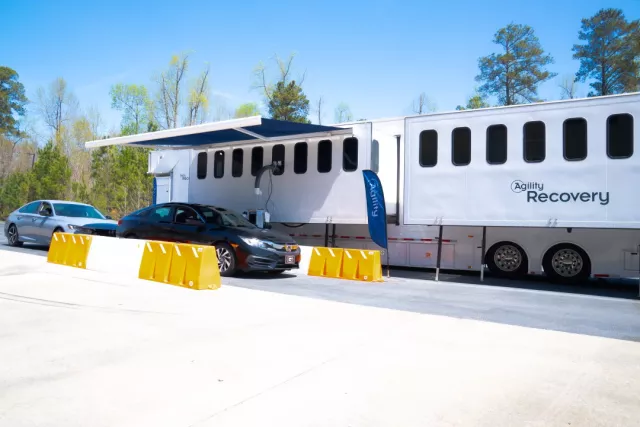COVID-19 Return-to-Work Guidance for Businesses

COVID-19 Return-to-Work Guidance for Businesses: Prepare Your Workplace and Employees
As more and more states and organizations are planning to reopen and return to the office, it is critical that businesses take action to prepare the workplace and employees for a safe and successful return. To aid in this transition, we have compiled best practices and considerations for businesses to include in their return-to-work plans.
Developing a Return-to-Work Plan
Establish a Planning and Response Team
We recommend establishing a cross-departmental pandemic emergency team responsible for planning, executing and monitoring your return-to-work plan. Key departments to include could be Human Resources, IT and Operations. Each team member should be given specific tasks and at least two members should be fully knowledgeable of every responsibility. Key tasks could include:
- Monitoring evolving local changes
- Communicating with employees and clients
- Keeping track of employee well-being
Make it Flexible
It is important to create a flexible return-to-work plan that can adapt to federal, state and local guidelines as COVID-19 continues to evolve. Consider creating a plan that takes different locations into account as local guidelines may differ.
Review and Update Human Resource Policies as Needed
- Make sure time off and sick leave policies and practices are consistent with public health recommendations, changing regulations and workplace laws.
- Consider providing employees with resources for mental health support.
Phased Employee Return Strategies and Considerations
Who Should Return First
Employers should assess their workforce and determine which employees to prioritize returning. Each business will prioritize differently but it is likely that many will begin with employees critical to operations or essential business functions and across different departments or locations.
- Consider volunteers first
- Consider asking employees if they are comfortable returning to work and include those that volunteer in the first phase
- Use an employee notification application to poll employees and group them into teams, groups, phases or locations
- Consider those that may not feel comfortable returning yet
- Individuals who are at higher risk
- Those that rely on childcare may need more time to return if childcare options are limited
Workplace Screening and Entrance
Since community spread of COVID-19 has been acknowledged by government health authorities, employers are currently allowed to take employee temperatures as they physically enter the workplace. In addition, employers may administer COVID-19 tests to employees before permitting entrance. For health and safety reasons, employers are currently allowed to deny entry of individuals that have COVID-19 or are showing related symptoms. If your business chooses to implement screening or testing, it is important to keep individual’s health information confidential.
Preparing the Workplace
Cleaning Facilities
You can leverage CDC recommendations to clean and disinfect facilities. Best practices include wearing disposable gloves while cleaning, using soap and water first, then using disinfectant. Practice routine cleaning of frequently touched surfaces like tables, doorknobs, lights, counter tops, handles, toilets etc. Also consider improving ventilation in the building and opening windows for increased air flow.
Implementing Social Distancing Practices
To avoid large gatherings and maintain distance (at least 6 feet) between employees, customers and visitors, companies should implement design changes and gathering alternatives or policies in the workplace. Examples of practices include:
- Increase physical space between employee worksites.
- Increase physical space between employees and customers (drive through, partitions, etc.)
- Consider limitations to cafeteria or break room areas to avoid gathering at any given time.
- Look into alternate office space solutions that can allow for a separated and distanced workforce or unexpected building closures. For example, one of our clients was not allowed into their building after someone in the building had tested positive.
Guideline Considerations for Workplace Behaviors
- In-Person Meetings or Gatherings
- Businesses may consider establishing guidelines for in-person meetings. Guidelines could include limiting the number of people allowed in rooms at any given time or even disallowing them until further notice. Companies may encourage alternative options for virtual meetings in the meantime.
- Business Travel
- Businesses should review their employee travel policies and monitor CDC’s travel recommendations to determine whether or not business travel is necessary. Businesses may consider halting or limiting business travel for the time being.
Safety Supplies
To help prevent spreading of the virus, provide extra cleaning and disinfecting supplies including hand soap, disinfecting spray, hand sanitizer, etc. In addition, consider providing or encouraging use of face masks, coverings or gloves. The CDC recommends wearing cloth face coverings in public settings where other social distancing measures are difficult to maintain. It is important to remind employees that wearing masks or personal protective equipment does not replace or eliminate the need for distancing, proper hand cleaning, and respiratory etiquette.
Employee Education and Communication
It is important to monitor and communicate federal, state and local updates and guidelines to employees as the pandemic evolves. Clear and constant communication of company guidelines and protocols can alleviate employee confusion and anxiety.
Train employees on best practices to prevent virus spread:
- Stay home if sick or showing symptoms.
- Wash hands often with soap and water for at least 20 seconds.
- Avoid touching eyes, nose, and mouth with unwashed hands.
- Cover mouth and nose with a tissue when you cough or sneeze or use the inside of your elbow.
- Avoid touching commonly touched surfaces when possible – elevator buttons, handles etc.
- Avoid using other employees’ phones, desks, offices, or other work tools and equipment, when possible. If necessary, clean and disinfect them before and after use.
- Practice social distancing by avoiding large gatherings and maintaining distance (approximately six feet) from others when possible.
What to do if an employee is sick or suspected of being sick:
Based on CDC recommendations, if an employee is sick or suspected of being sick, the following actions should be taken:
- Employees who have symptoms (fever, cough, or shortness of breath) when they arrive at work or become sick during the day should immediately be separated from other employees, customers, and visitors and sent home.
- Employees who develop symptoms outside of work should notify their supervisor and stay home.
- Employees should not return to work until they have met the criteria to discontinue home isolation and have consulted with a healthcare provider.
- In most cases, you do not need to shut down your facility, but do close off and clean any areas used for prolonged periods of time by the sick person.
- Wait 24 hours before cleaning and disinfecting to minimize potential for other employees being exposed to respiratory droplets.
Looking Forward: Preparedness Plans and Response
Organizations should be prepared to respond in the event of a recurrence of the outbreak and determine what that means for their workforce and operations. We have created resources for developing a pandemic preparedness and response plan with best practices to keep your people safe and sustain business operations.
Companies with business continuity and pandemic response plans should take time to evaluate their plan specific to their COVID-19 response to identify gaps and update for future interruptions. Here are some examples of information to gather when evaluating your plans:
- Expectations vs. realities
- What went well
- Areas for improvement
- Unforeseen challenges and response
- Alternative workspace options
- Remote work challenges
As the process of reopening and returning to work evolves, we encourage all businesses to follow CDC and local guidelines on reopening, social distancing and health best practices.



